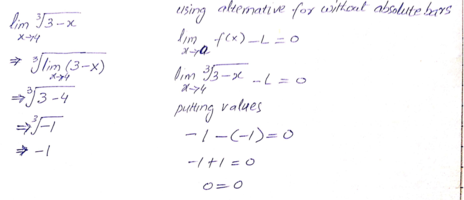Solution to a limit problem can be written in an alternative form (property) as following:
limx->a f(x) = L if and only if limx->a |f(x) – L|= 0
(ref: alternative form property Mustafa Munem Calculus > section 1.8 > page 64)
I don’t understand the significance and necessity of absolute value bars here because in the following example I get the alternative form equation satisfied on both LHS and RHS.

limx->a f(x) = L if and only if limx->a |f(x) – L|= 0
(ref: alternative form property Mustafa Munem Calculus > section 1.8 > page 64)
I don’t understand the significance and necessity of absolute value bars here because in the following example I get the alternative form equation satisfied on both LHS and RHS.

